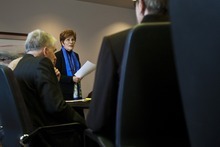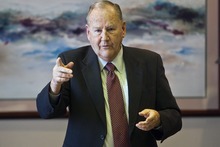This is an archived article that was published on sltrib.com in 2011, and information in the article may be outdated. It is provided only for personal research purposes and may not be reprinted.
A nonpartisan group of prominent Utahns is calling on the Legislature to create an independent commission as part of the upcoming redistricting — a redrawing of political boundaries that happens every 10 years.
At a news conference Wednesday, Utah Citizens' Counsel organizer Aileen Clyde, a former member of the Utah State Board of Regents, said redistricting plans favorable to Republicans have ensured the state's elections are some of the least competitive in the nation.
"Utah has a healthy sense of competition when it comes to sporting events," Clyde said. "We seem not to have the same values in political debate."
National studies in recent years rank Utah among the lowest for eligible-voter participation in elections.
The citizen group is made up of such notables as former Utah Gov. Olene Walker; former University of Utah President Chase Peterson; former Weber State University President Paul Thompson; and former state legislator Karl Snow.
Buoyed by a recent Salt Lake Tribune poll indicating that 73 percent of Utahns support an independent redistricting commission, organizers plan to draw up their own redistricting proposals and hold statewide public meetings to generate pressure on legislators.
Former Congress members Jim Hansen, a Republican, and Karen Shepherd, a Democrat, support the effort.
Shepherd pointedly responded to Utah House Speaker Becky Lockhart's recent comments that the Legislature is solely responsible for redistricting.
"Nothing in the constitution bars the Legislature from taking input from an independent commission," she said.
Hansen said legislators do an excellent job in areassuch as transportation and the state budget, where they have expert knowledge, but they do poorly in the redrawing of political maps.
A 22-year veteran of the U.S. House, Hansen was in office through three redistrictings, from 1981 to 2001. He said that due to "gerrymandering," at one time or another his 1st District seat included all or parts of every county.
Hansen said the process in 2001 was especially dispiriting, when the three Utah congressmen — himself, then-Rep. Chris Cannon, a Republican, and Rep. Jim Matheson, a Democrat — agreed on a plan they all considered fair.
Then state legislators completely changed it in an effort to oust Matheson, he said.
"My own party disappointed me a little bit," he said.
Republican efforts to rid Utah of its lone congressional Democrat, though, backfired. Ten years later, Matheson is still in office, and with his district extended to rural areas of the state, he's become a figure who could win a statewide election.
"They created a giant," Hansen said.
The redistricting reform group, which came together about two years ago, has come up with a list of principles it wants to see incorporated into any remapping plan, including keeping municipalities and counties within a single district whenever possible.
Currently, several state House and Senate districts crisscross some counties. Two state senators and three representatives, for example, represent different parts of thinly populated Sanpete County. In another example, four state senators represent Tooele County, none of them living inside its borders.
The U.S. Constitution requires realignment of congressional and legislative districts to match shifting populations after each 10-year census.
Other organization such as AARP of Utah, the League of Women Voters and Utahns for Ethical Government are also throwing their support behind the reform group's effort. —
Utah Citizens' Counsel
• The group's list of redistricting principles is detailed on its website, www.utahcitizens counsel.org.







